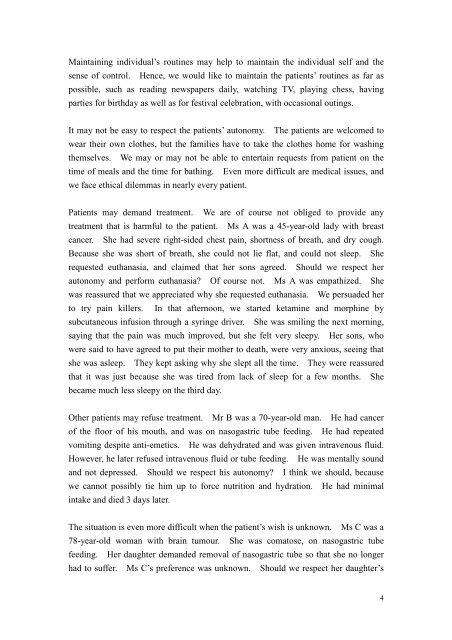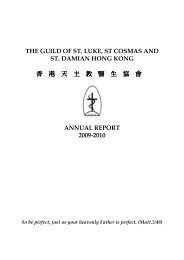Full paper Human dignity in patients with terminal illness
Full paper Human dignity in patients with terminal illness
Full paper Human dignity in patients with terminal illness
You also want an ePaper? Increase the reach of your titles
YUMPU automatically turns print PDFs into web optimized ePapers that Google loves.
Ma<strong>in</strong>ta<strong>in</strong><strong>in</strong>g <strong>in</strong>dividual’s rout<strong>in</strong>es may help to ma<strong>in</strong>ta<strong>in</strong> the <strong>in</strong>dividual self and thesense of control. Hence, we would like to ma<strong>in</strong>ta<strong>in</strong> the <strong>patients</strong>’ rout<strong>in</strong>es as far aspossible, such as read<strong>in</strong>g news<strong>paper</strong>s daily, watch<strong>in</strong>g TV, play<strong>in</strong>g chess, hav<strong>in</strong>gparties for birthday as well as for festival celebration, <strong>with</strong> occasional out<strong>in</strong>gs.It may not be easy to respect the <strong>patients</strong>’ autonomy. The <strong>patients</strong> are welcomed towear their own clothes, but the families have to take the clothes home for wash<strong>in</strong>gthemselves. We may or may not be able to enterta<strong>in</strong> requests from patient on thetime of meals and the time for bath<strong>in</strong>g. Even more difficult are medical issues, andwe face ethical dilemmas <strong>in</strong> nearly every patient.Patients may demand treatment. We are of course not obliged to provide anytreatment that is harmful to the patient. Ms A was a 45-year-old lady <strong>with</strong> breastcancer. She had severe right-sided chest pa<strong>in</strong>, shortness of breath, and dry cough.Because she was short of breath, she could not lie flat, and could not sleep. Sherequested euthanasia, and claimed that her sons agreed. Should we respect herautonomy and perform euthanasia? Of course not. Ms A was empathized. Shewas reassured that we appreciated why she requested euthanasia. We persuaded herto try pa<strong>in</strong> killers. In that afternoon, we started ketam<strong>in</strong>e and morph<strong>in</strong>e bysubcutaneous <strong>in</strong>fusion through a syr<strong>in</strong>ge driver. She was smil<strong>in</strong>g the next morn<strong>in</strong>g,say<strong>in</strong>g that the pa<strong>in</strong> was much improved, but she felt very sleepy. Her sons, whowere said to have agreed to put their mother to death, were very anxious, see<strong>in</strong>g thatshe was asleep. They kept ask<strong>in</strong>g why she slept all the time. They were reassuredthat it was just because she was tired from lack of sleep for a few months. Shebecame much less sleepy on the third day.Other <strong>patients</strong> may refuse treatment. Mr B was a 70-year-old man. He had cancerof the floor of his mouth, and was on nasogastric tube feed<strong>in</strong>g. He had repeatedvomit<strong>in</strong>g despite anti-emetics. He was dehydrated and was given <strong>in</strong>travenous fluid.However, he later refused <strong>in</strong>travenous fluid or tube feed<strong>in</strong>g. He was mentally soundand not depressed. Should we respect his autonomy? I th<strong>in</strong>k we should, becausewe cannot possibly tie him up to force nutrition and hydration. He had m<strong>in</strong>imal<strong>in</strong>take and died 3 days later.The situation is even more difficult when the patient’s wish is unknown. Ms C was a78-year-old woman <strong>with</strong> bra<strong>in</strong> tumour. She was comatose, on nasogastric tubefeed<strong>in</strong>g. Her daughter demanded removal of nasogastric tube so that she no longerhad to suffer. Ms C’s preference was unknown. Should we respect her daughter’s4




